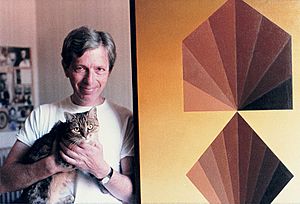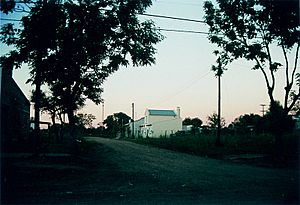Roberto Aizenberg facts for kids
Quick facts for kids
Roberto Aizenberg
|
|
|---|---|
 |
|
| Born | 22 August 1928 Federal, Entre Ríos, Argentina
|
| Died | 16 February 1996 (aged 67) Buenos Aires, Argentina
|
| Nationality | Argentinian |
| Education | Colegio Nacional de Buenos Aires; Antonio Berni; Juan Batlle Planas |
| Known for | Painting, Sculpture |
| Movement | Surrealism |
| Spouse(s) | Matilde Herrera |
Roberto Aizenberg (born August 22, 1928 – died February 16, 1996) was an Argentinian painter and sculptor. People often called him "Bobby." He was famous for his unique style of art called Surrealism in Argentina.
Contents
A Young Artist's Journey
Roberto Aizenberg's grandparents were Russian-Jewish immigrants. They settled in special farming communities in Entre Ríos Province, Argentina. Roberto was born in the town of Villa Federal.
When he was eight, his family moved to La Paternal, a neighborhood in Buenos Aires. He finished his high school education at the Colegio Nacional de Buenos Aires.
Roberto first started studying to become an architect. But he soon decided to follow his passion for art instead. He became a student of the famous artist Antonio Berni. From 1950 to 1953, he also studied with Juan Batlle Planas. Planas was a unique surrealist artist who taught Roberto about surrealism and how it connected with psychology.
His Art Career
Roberto Aizenberg had his very first art show in 1958 at the Galeria Galatea. After that, he had six more solo shows. In 1969, a big show of his work was held at the Torcuato di Tella Institute. This show included many of his collages, sculptures, paintings, and drawings.
His art was also shown in many group exhibitions. One important one was the 1963 São Paulo Bienal. His first art show in Europe was in 1972 in London. The next year, his work was shown in Zürich, Switzerland. In 1982, his art was displayed in Milan, Italy.
Later in his career, Roberto also shared his knowledge with others. He taught painting at the Instituto Universitario Nacional del Arte in 1985–1986 and again in 1993.
What His Art Looks Like
Roberto Aizenberg really admired architecture, especially the buildings from the Renaissance period. This love for buildings deeply influenced his artwork.
His paintings often show:
- Tall, lonely towers
- Empty towns
- Mysterious buildings that seem uninhabited
- Unusual, many-sided structures
He used special slow-drying oils to make his paintings look very smooth and perfect.
Roberto also had strong ideas about how art should be taught. He believed that artists should not just copy models. He felt that copying models made art less free and creative. For him, modern art was about creating something new, not just imitating what you see.
Many of his artworks can be seen at the Fortabat Art Collection Museum.
His Personal Life
Roberto Aizenberg married Matilde Herrera, a journalist and writer. Matilde had three children from a previous marriage: Valeria, José, and Martín. They all lived together.
In 1976 and 1977, during a difficult political time in Argentina, Matilde's three children and their spouses faced serious challenges. Because of these events, Roberto had to leave Argentina for his safety. He moved to Paris, France, in 1977. In 1981, he moved to Tarquinia, Italy.
He returned to Argentina three years later. Roberto Aizenberg passed away in Buenos Aires in 1996. At the time, he was getting ready for a big show of his art at the National Museum of Fine Arts.
Awards and Recognition
Roberto Aizenberg received several awards for his artistic talent:
- Automóvil Club Argentino Award
- Acquarone Prize in 1962
- First prize for painting at the Instituto de Tella in 1963
- Cassandra Foundation Prize from Chicago in 1970
- Konex Award in both 1982 and 1992
See also
 In Spanish: Roberto Aizenberg para niños
In Spanish: Roberto Aizenberg para niños


